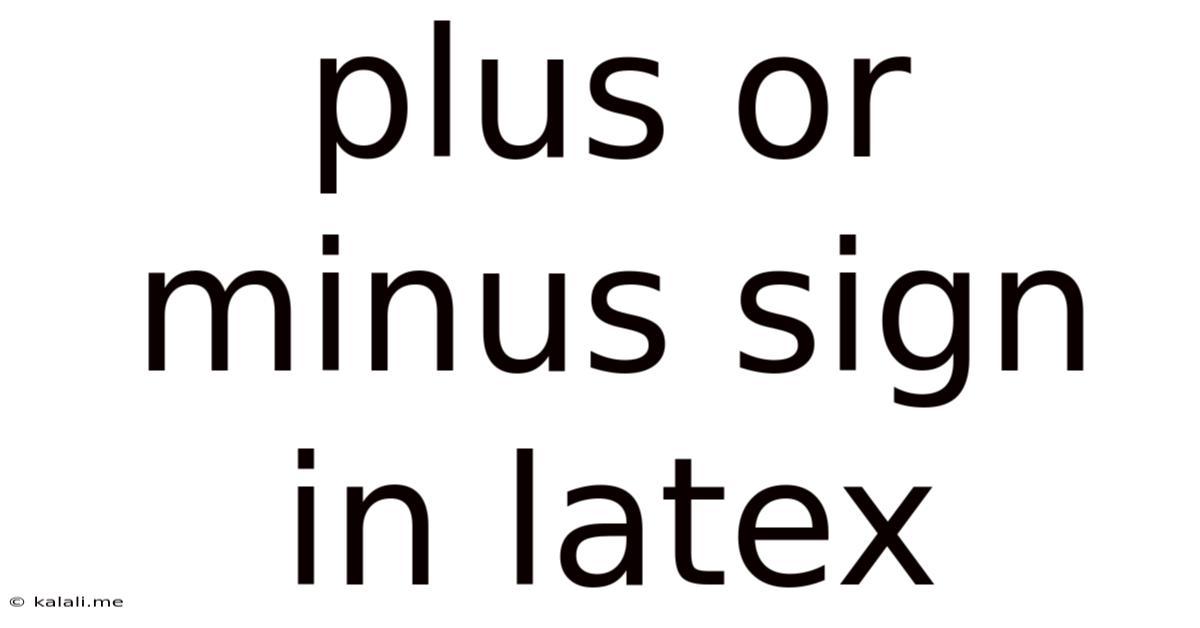Plus Or Minus Sign In Latex
Kalali
Jun 10, 2025 · 3 min read

Table of Contents
Plus and Minus Signs in LaTeX: A Comprehensive Guide
LaTeX, a powerful typesetting system, offers several ways to represent plus and minus signs, catering to various mathematical and stylistic needs. This guide covers the different options, from simple plus and minus symbols to more nuanced applications like ± and ∓. Understanding these options ensures your documents are both accurate and aesthetically pleasing. This article will cover basic usage, variations, and advanced techniques for incorporating plus and minus signs effectively in your LaTeX documents.
Basic Plus and Minus:
The simplest way to display plus (+) and minus (-) signs is to use the standard characters directly in your LaTeX code. This works perfectly well for most basic mathematical expressions.
This is a plus sign: +
This is a minus sign: -
Result: 5 + 3 = 8 and 10 - 4 = 6
Plus-Minus Sign ( ± ):
The plus-minus sign ( ± ), indicating both addition and subtraction, is commonly used to express a range of values or uncertainty. In LaTeX, you use the \pm command:
The measurement is 10 \pm 2 cm.
This will render as "The measurement is 10 ± 2 cm." This symbol is crucial for representing error margins, statistical data, and approximations in scientific and engineering documents.
Minus-Plus Sign ( ∓ ):
The less frequently used minus-plus sign ( ∓ ) is the opposite of the plus-minus sign. It’s typically used in conjunction with \pm to express a relationship where one symbol is positive while the other is negative.
cos(x \pm y) = cos(x)cos(y) \mp sin(x)sin(y)
Here, when you have + in the argument, you'll get - in the result, and vice-versa. This subtlety requires careful understanding and correct usage. Incorrect application can lead to ambiguity.
Scaling and Sizing:
While the standard plus and minus signs generally suffice, you may need to adjust their size in certain contexts, especially within complex mathematical expressions or large displays. LaTeX's \mathrel command, combined with sizing commands like \textstyle, \displaystyle, or \scriptstyle, can help manage the size and spacing appropriately. However, it's often best to let LaTeX handle spacing automatically, especially for simple expressions, to maintain consistency.
Advanced Techniques and Contextual Usage:
The best approach often depends on the context. For simple equations within paragraphs, basic plus and minus characters are fine. However, for formal mathematical expressions or displays, using the dedicated commands (\pm and \mp) enhances readability and clarity, aligning with mathematical typographic conventions. Remember consistency is key: maintain a uniform style throughout your document.
Troubleshooting and Common Errors:
Incorrect spacing or sizing issues can arise if you don't use the correct commands or accidentally mix text mode with math mode. Always ensure your plus and minus signs are within the appropriate math environment ($...$ for inline math or \[...\] for displayed equations).
This guide provides a foundational understanding of using plus and minus signs in LaTeX. By understanding these different options and their appropriate contexts, you can create clear, concise, and mathematically correct documents. Remember to consult LaTeX documentation for advanced usage and further options related to mathematical typesetting.
Latest Posts
Latest Posts
-
Do The Contestants On Naked And Afraid Get Paid
Jul 01, 2025
-
How Many Yards Are In 7 Feet
Jul 01, 2025
-
What Is Shortest Book In The Bible
Jul 01, 2025
-
How Many Cups Of Orzo In A Pound
Jul 01, 2025
-
How Long Does It Take To Drive 30 Miles
Jul 01, 2025
Related Post
Thank you for visiting our website which covers about Plus Or Minus Sign In Latex . We hope the information provided has been useful to you. Feel free to contact us if you have any questions or need further assistance. See you next time and don't miss to bookmark.